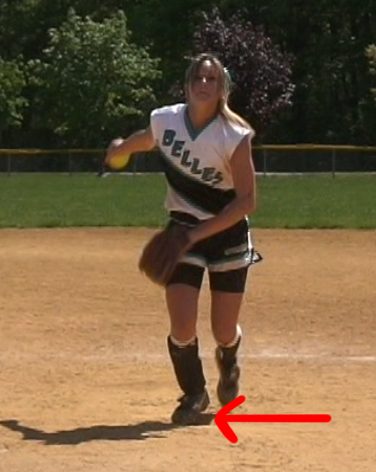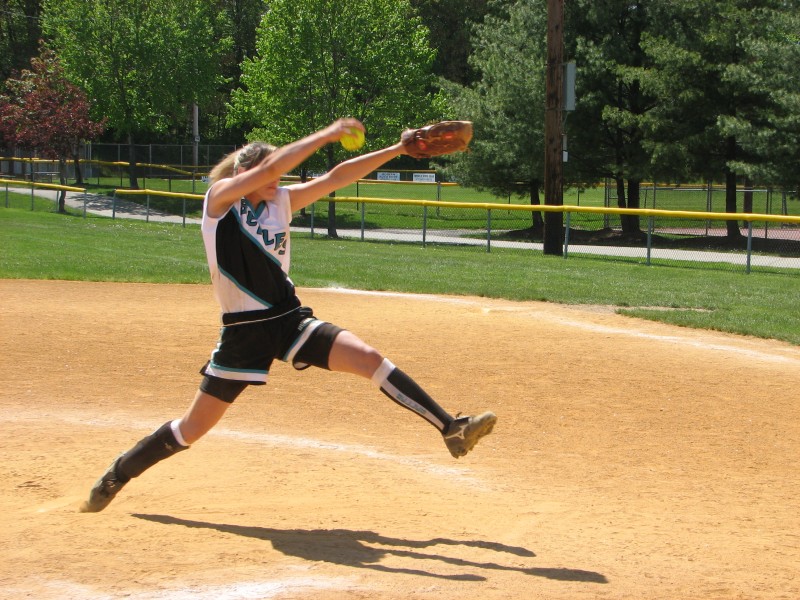Pitching Drills for a Smoother Drive-through
A little while ago I received an email from a Fastpitch Power reader asking for specific windmill pitching drills to address the issues of turning the load foot and dragging it during the drive-through. The reader was right; though we’ve discussed these issues at length, we’ve been a little light on info regarding how to fix them. I see more pitchers every day having problems dragging their feet, and since it’s so prevalent, I want to share my response with all of you.
Drive-through Drill #1: Fixing the Load Foot Turn
Please revisit my post on turning the load foot if you’re unsure of what I mean by this. I find that among pitchers who do this, many don’t realize WHEN they’re doing it, or that they’re doing it at all. In that case, the best way to fix it is to start with some feedback.
Place something small, solid, and a little heavy, ideally a brick or a similarly sized block, next to the instep of the load foot on the pitching rubber, right here:

Then pitch normally. When the foot turns during the load, the heel will come in contact with the object. If this happens, the pitcher should stop and try again until she can consistently pitch normally without her foot interfering with the object. Then remove the object, and continue to pitch, focusing on keeping the foot still during the load.
Drive-through Drill #2: Getting a Good Transition
The key to a good drive through is proper knee and toe position, as discussed in this video and this video. If your knee and toe end up in the right position, it doesn’t even matter what your foot does in the load (it just so happens that a majority of the time, a turned foot in the load causes poor knee and toe position in the drive-through). The knee should be pointed at the target and the big toe should be grazing the ground, like this:

The key to ending up in this position is making sure that the transition from the push to the stride does not turn the knee out to the side. The knee should stay forward during that transition, even as the upper body tracks. One of our favorite drills for this and just about any problem is reach, track, fire. It breaks down the pitch into 3 parts and gives the pitcher time to focus on areas of concern (in this case, how the drive-through leg transitions from reach to track). Watch this video to learn the drill, and notice how the demonstrating pitcher’s knee remains forward during the transition:
Drive-through Drill #3: Do It Without The Ball
Once you have a feel for the correct transition, mime a full motion without a ball. Don’t be lazy; do it aggressively as if you were actually pitching. Focus on a good transition and smooth drive-through. Many people find that without the ball, it comes naturally. Do it 50-100 times without the ball, then pick up the ball and pitch without worrying about the target, trying to focus on getting your body to feel the same way it did without the ball. Alternate one pitch with the ball and one pitch without until the motions become the same.
Ask and you shall receive! If you ever have any questions, leave a comment or contact us and we’ll write about them.
thank you carly!
Thank YOU for bringing it to my attention!
Carly,
Just want to thank you and your father for all the great videos and knowledge you are passing on. My Daughter is 16 and has been pitching since she was 10 at a very competitive level, and has been very successful her 1st two years in High School as well. One of things that has been the hardest for her to understand and actually do is the driving out over the toe without turning the foot. Since found your website she has worked really hard on this and has finally at a point where she does it every time. She picked up speed right away. But what we are battling now is that where once she was very good at hitting her spots, now she is a bit inconsistant, and high on most pitches. I know it is probably because of her arm speed and timing being better. But she is having trouble getting the ball down. What are your thoughts on this? Also I am glad to see you visit discussfastpitch.com I have been going there for years and what you and Phil have posted is very much needed. They tend to be stuck in their ways over there and don’t readily accept new ways of explaining things. Keep up the good work.
Thanks Brian!
I would have to see video of your daughter to know exactly what’s going on, but I can tell you the most popular reasons for throwing high. Watch out for her landing with her posture lower than maximum and then getting suddenly taller as she does her drive through and releases the ball. If there is any sort of distinct upward movement in her body during delivery, the ball will go up.
If her motion looks good and you think it’s just timing, tell her to lower her eyes. She can look at a spot below the catcher’s glove, or even the plate, and fire there as hard as she can. Hope that helps!
my 10 year old year old is stepping at the end of her pitch. She doesn’t seem to do it every time, but enough for the other coaches to notice and occasionally the umpire. Will the section pitching drills for a smoother drive through on your website also help her with this problem. Shes not even aware shes doing it. Im trying to help her with it, her pitching coach is also trying to help, but she still does it. thanks for any help
Hi Robert,
I’m not sure what you mean by stepping at the end of her pitch. Which leg is she stepping with? Can you be more specific with your description? Thanks!
instead of dragging her right foot, she is stepping forward and the umpires are calling her on it. ive tried everything I can, but she still does it. shes a right handed pitcher, she pushes off and goes through the pitching motion, but she does not leave the right foot on the ground, sometimes she drags it a little.
She can try these drills: https://www.fastpitchpower.com/windmill-pitching-drills-to-stop-crow-hopping/
If it doesn’t help, we’d have to perform a video analysis to determine exactly what’s causing the problem.
HI! Carly,
I’m 16 , I practice daily!
Heavy ball, k drills, walk through, protract and re tract arm drills, wrist snaps.Then pitching!
I know I drag my back leg so much probably about 5 ft. but I can’t get it up, when I do it pulls something in my back. I think I am leaning back also trying and push the ball through the last 12 inches.. I am concerned all this practice and time spent with my dad practicing is not paying off and I will never get recruited.